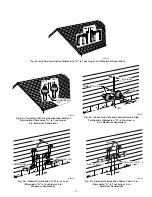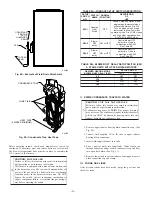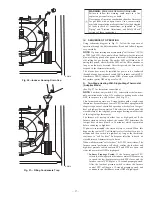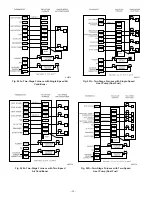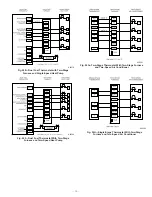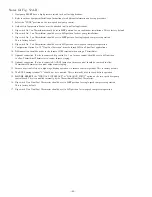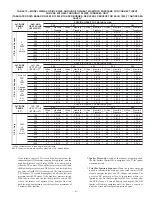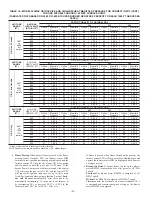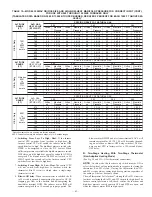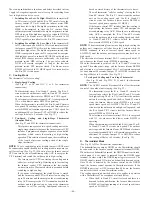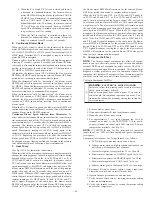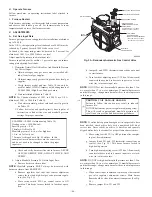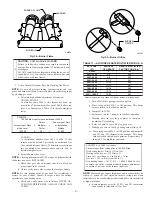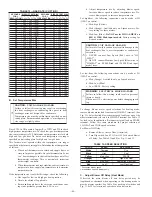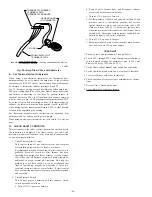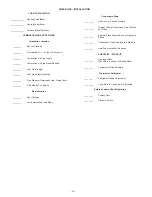
D.
Set Thermostat Heat Anticipator
When using a nonelectronic thermostat, the thermostat heat-
anticipator must be set to match the amp draw of the electrical
components in R-W/W1 circuit. Accurate amp draw readings can
be obtained at thermostat subbase terminals R and W.
Fig. 56 illustrates an easy method of obtaining actual amp draw.
The amp reading should be taken after blower motor has started
and furnace is operating in low heat. To operate furnace in
low-heat, first move SW-1 to ON position, then connect ammeter
wires as shown in Fig. 56. The thermostat anticipator should NOT
be in the circuit while measuring current. If thermostat has no
subbase, the thermostat must be disconnected from R and W/W1
wires during current measurement Return SW-1 to final desired
location after completing the reading.
See thermostat manufacturer’s instructions for adjusting heat
anticipator and for varying heating cycle length.
When using an electronic thermostat, set cycle rate for 3 cycles per
hour.
VI.
CHECK SAFETY CONTROLS
This section covers the safety controls that must be checked before
the installation is complete. The flame sensor, gas valve, and
pressure switch were all checked in the Start-up Procedure section
as part of normal operation.
1. Check Primary Limit Control
This control shuts off gas control system and energizes
air-circulating blower motor if furnace overheats.
Recommended method of checking this limit control is to
gradually block off return air after furnace has been
operating for a period of at least 5 minutes. As soon as limit
control has shut off burners, return-air opening should be
unblocked to permit normal air circulation. By using this
method to check limit control, it can be established that
limit is functioning properly and operates if there is a
restricted return-air duct or motor failure. If limit control
does not function during this test, cause must be determined
and corrected.
2. Check Pressure Switch
This control proves operation of draft inducer. Check
switch operation as follows:
a. Turn off 115-v power to furnace.
b. Remove outer furnace door and disconnect inducer
motor lead wires from wire harness.
c. Turn on 115-v power to furnace.
d. Set thermostat to
″
call for heat
″
and wait 1 minute. When
pressure switch is functioning properly, hot surface
igniter should not glow, and control status code LED
flashes a Status Code 32. If hot surface igniter glows
when inducer motor is disconnected, shut furnace down
immediately. Determine reason pressure switch did not
function properly and correct condition.
e. Turn off 115-v power to furnace.
f. Reconnect inducer motor leads, reinstall main furnace
door, and turn on 115-v power supply.
CHECKLIST
1. Put away tools and instruments. Clean up debris.
2. Check SW-1 through SW-3 after completing installation to
ensure desired settings for thermostat type (SW-1) and
blower-OFF delay (SW-2 and SW-3).
3. Verify flame rollout manual reset switch has continuity.
4. Verify that blower and main doors are properly installed.
5. Cycle test furnace with room thermostat.
6. Check operation of accessories per manufacturer’s instruc-
tions.
7. Review User’s Guide with owner.
8. Leave literature packet near furnace.
Fig. 56—Amp Draw Check with Ammeter
A80201
R
Y W G
10 TURNS
THERMOSTAT SUBBASE
TERMINALS WITH
THERMOSTAT REMOVED
HOOK-AROUND
VOLT/AMMETER
EXAMPLE:
5.0 AMPS ON AMMETER
10 TURNS AROUND JAWS
= 0.5 AMPS FOR THERMOSTAT SETTING
FROM UNIT 24-VOLT
TERMINAL BLOCK
—49—
Содержание CONDENSING GAS FURNACE 352MAV
Страница 51: ...51...

